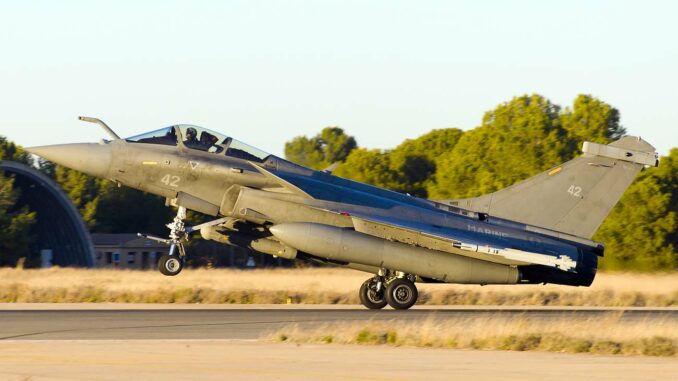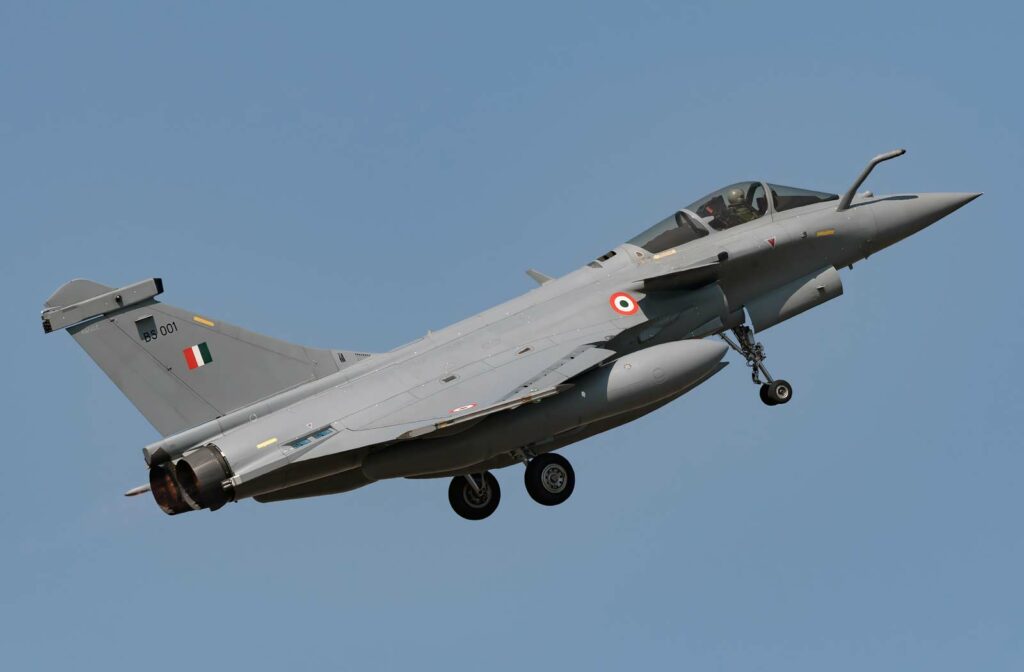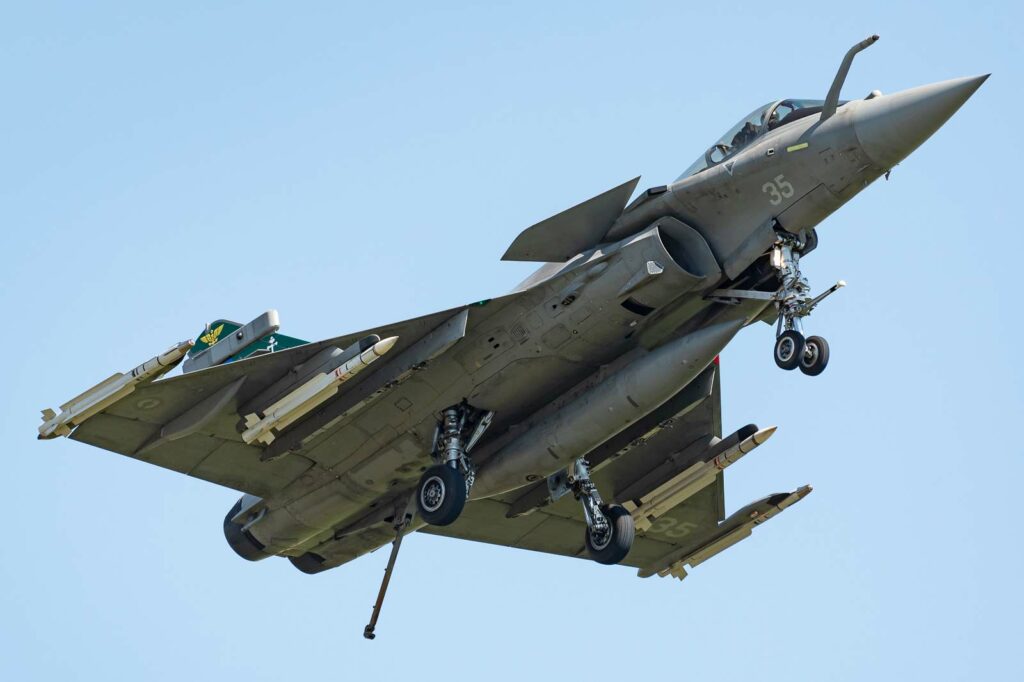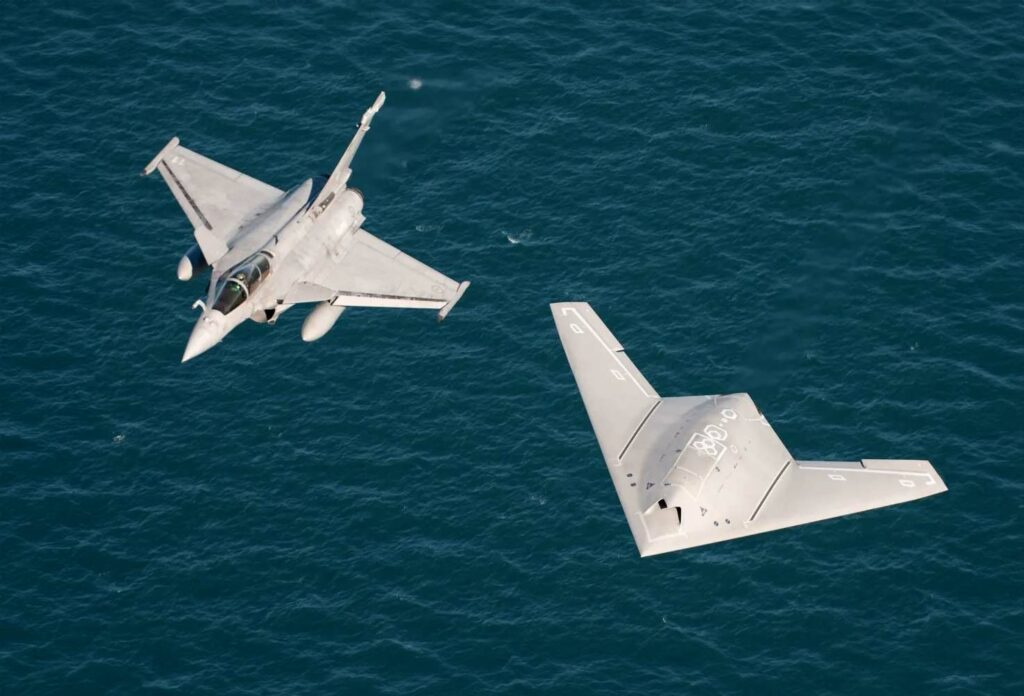
The Dassault Rafale F5 is the technological heir to the Rafale variants, the French multi-role fighter that dates back to the 2000s.
The Dassault Rafale is a multi-role fighter aircraft designed and manufactured by Dassault Aviation, a French company. Renowned for its versatility, the Rafale can perform a variety of missions, including air superiority, ground attack, reconnaissance and nuclear deterrence. This multi-role capability distinguishes it as a central element of the French air and naval forces, ensuring its strategic place in national defense. Used by both the French Air Force and Navy, the Rafale plays a crucial role in maintaining France’s security and sovereignty. Its cutting-edge technology and capacity for evolution, as illustrated by the upgrade to the Rafale F5 standard, guarantee its relevance in the context of modern warfare. The aircraft is also a successful export product, symbolizing French technological know-how on the international stage.

The beginning: Standard F1
The Standard F1 represents the first operational version of the Dassault Rafale, an iconic French fighter. Launched in the early 2000s, this model was specifically designed to meet the requirements of the French Navy, with an emphasis on air superiority and interception missions at sea. The Rafale F1 was distinguished by its ability to operate from an aircraft carrier, integrating advanced technologies for naval operations.
Equipped with a multi-mode radar capable of detecting and engaging airborne targets, the F1 was armed for air defense missions, and fitted with MICA missiles for long-range interception. Although this version did not have full air-to-ground capability, it played a crucial role in protecting naval forces and securing maritime airspace.
With a top speed of around Mach 1.8 (over 2,000 km/h), a combat range of 1,850 kilometers, and the ability to fly at altitudes of over 15,000 meters, the Rafale F1 demonstrated considerable power and flexibility for naval air operations. This standard laid the technical and operational foundations for future Rafale evolutions, enabling upgrades to more advanced standards, such as the F2 and F3, which would extend its capabilities to full multi-role roles.
Transition and Upgrade: From F2 to F3R
The transition of the Dassault Rafale from the F2 standard to the F3 and F3R illustrates a significant evolution in the fighter’s versatility and technological capabilities. The F2 standard, introduced in the mid-2000s, marked an important milestone, offering air-to-air and air-to-ground operational capabilities for the first time, making the Rafale suitable for a wider range of military missions.
The F2 enhanced the Rafale’s operational flexibility, equipped with advanced systems enabling the deployment of air-to-ground guided munitions in addition to its air-to-air capabilities. It could reach speeds in excess of Mach 1.8, with a range of over 3,700 km in ferry configuration and the ability to operate at altitudes in excess of 15,000 meters.
The F3 standard then extended these capabilities, introducing improvements such as the RBE2-AA (Active Electronically Scanned Array) radar, offering improved target detection and tracking. The F3R, a subsequent upgrade, consolidated the Rafale’s place as an extremely capable weapon system, integrating the long-range Meteor missile and the SCALP cruise missile, considerably increasing the aircraft’s lethality and flexibility.
These developments have transformed the Rafale into a highly adaptable platform, capable of carrying out a wide range of missions, from air superiority to deep precision strikes. In particular, the upgrade to the F3R standard has enhanced its capabilities in contested environments, ensuring operational superiority against increasingly sophisticated threats.

Technological revolution: the F4 standard
The F4 standard on the Dassault Rafale represents a major technological revolution, marking a significant advance in the capabilities of this fighter. Introduced with the aim of adapting the Rafale to future battlefield requirements, the F4 incorporates cutting-edge innovations in connectivity, survival in highly contested areas, and reconnaissance, reinforcing its role as an advanced weapon system.
A key feature of the F4 is its open system architecture, designed to facilitate regular upgrades and the integration of new technologies. This flexibility ensures that the Rafale can quickly adapt to technological developments and emerging threats. Enhancements include advanced electronic warfare systems, improved data link capability, and improved stealth features, enabling the Rafale to maintain its operational superiority in contested environments.
F4 innovations also enhance the Rafale’s connectivity with other platforms, enabling unprecedented integration into joint and combined operations. The Rafale F4 is capable of operating as a node in a combat network, exchanging information in real time with other players, thus increasing its ability to operate in network-centric warfare.
With a speed that remains above Mach 1.8, an extended operational range, and improved reconnaissance and targeting capabilities, the Rafale F4 continues to set the standards for performance, survivability and versatility, ensuring that this aircraft remains among the most capable in the world’s skies.
Into the Future: Dawn of the Rafale F5
The Dassault Rafale F5 standard is envisaged as a revolution in combat aviation, representing the next generation in terms of technological and operational capabilities. This development is focused on substantially improving sensory capabilities and integrating cutting-edge technologies, preparing the Rafale to meet the challenges of contemporary and future threats.
Expected to offer an advanced suite of sensors and electronic systems, the F5 aims to significantly enhance situational awareness, targeting accuracy and network connectivity, enabling unprecedented interoperability with allied forces. Planned enhancements include the integration of new stealth technologies, advanced electronic warfare systems, and next-generation weaponry, ensuring unchallenged air dominance.
The evolutionary potential of the Rafale F5 is crucial to its continued relevance in future air combat doctrine, particularly in terms of deterrence. The F5 is designed to operate in increasingly contested environments, offering enhanced capabilities to deal with sophisticated adversaries equipped with cutting-edge technologies. This update aims to ensure that the Rafale remains a central platform in defense strategy, capable of responding effectively to emerging conflict scenarios and ensuring the protection of national and international interests.
By incorporating advances in artificial intelligence, cyber defense and stealth technologies, the Rafale F5 is ready to become a pillar of the air force, offering increased versatility, power and operational efficiency for decades to come.

Rafale F5: a fighter in transition to the SCAF
The Rafale F5 is the new variant of the French Dassault Rafale fighter, representing a significant step forward in its series. This new version should include enhanced capabilities, notably in electronic warfare, and will operate in conjunction with nEUROn combat drones (UCAVs). Unlike its predecessors, the Rafale F5 is not expected to have a version specifically dedicated to the suppression of enemy air defenses/destruction of enemy air defenses (SEAD/DEAD) role. Instead, it will rely on nEUROn UAVs to perform these tasks, acting as a “loyal wingman” to the Rafale F5, enhancing its operational capabilities and strategic flexibility.
The Rafale F5 aims to function as a flying tactical command post, focusing on sensor integration, data fusion and processing capabilities, similar to the advanced sensor fusion technology found in the F-35. This approach is part of a broader strategy to adapt to the evolving nature of modern air warfare, which increasingly incorporates advanced electronic warfare and network-centric operations. The aircraft will continue to use the evolving SPECTRA self-protection system, which guarantees a robust electronic warfare and countermeasures capability.
In addition, the Rafale F5 is expected to handle large volumes of data, which will require enhancements such as more powerful mission computers and advanced fiber optic cabling, in line with the technological requirements of next-generation combat aircraft. This aircraft is part of France’s long-term defense strategy, with the French Ministry of the Armed Forces emphasizing its importance alongside future defense systems such as the Future Combat Air System (FCAS).
Perspectives on the future of the Rafale in relation to the FCAS
The Dassault Rafale, a leading fighter aircraft, is at the heart of discussions on the future of military aviation, particularly in relation to the Future Air Combat System (SCAF). The SCAF is a European initiative to develop a new generation of combat air systems, integrating fighter aircraft, UAVs and combat cloud technologies, scheduled to enter service by 2040.
The Rafale, with its ongoing upgrades, plays a pivotal role in this transitional landscape, serving as a bridge between current capabilities and future technologies. The Rafale is expected to continue evolving, integrating advanced technologies that will be crucial to the SCAF, such as artificial intelligence, enhanced connectivity, and advanced stealth. These enhancements will enable the Rafale to operate effectively alongside the new SCAF players, ensuring essential interoperability and complementarity.
The Rafale’s positioning in a changing strategic environment is crucial. With growing geopolitical tensions and rapidly evolving military technology, the Rafale must remain at the cutting edge of technology to ensure deterrence and defense. Its role in the SCAF underlines its continuing importance not only as a defense tool, but also as a vector of technological innovation, ready to adapt to future threats and integrate new capabilities into the air arsenal of France and its allies.
The future of the Rafale is intrinsically linked to that of the SCAF, playing an essential role in the transition to a new era of air warfare and reinforcing its status as a central pillar of European air defense in a changing global context.
War Wings Daily is an independant magazine.